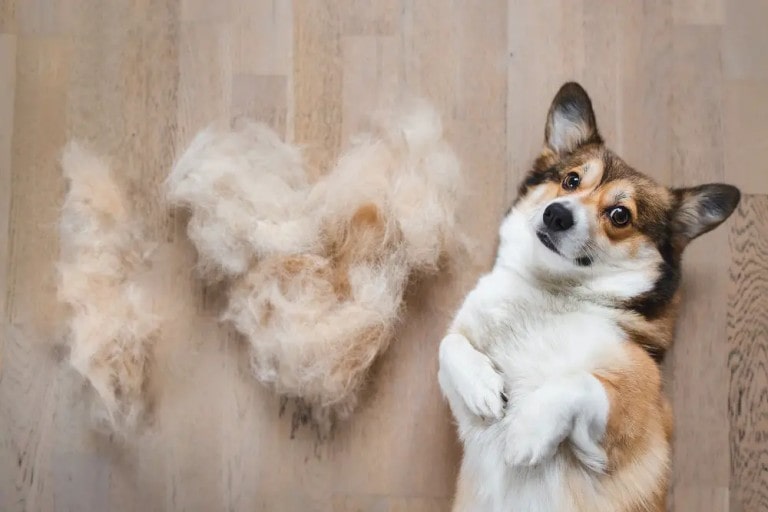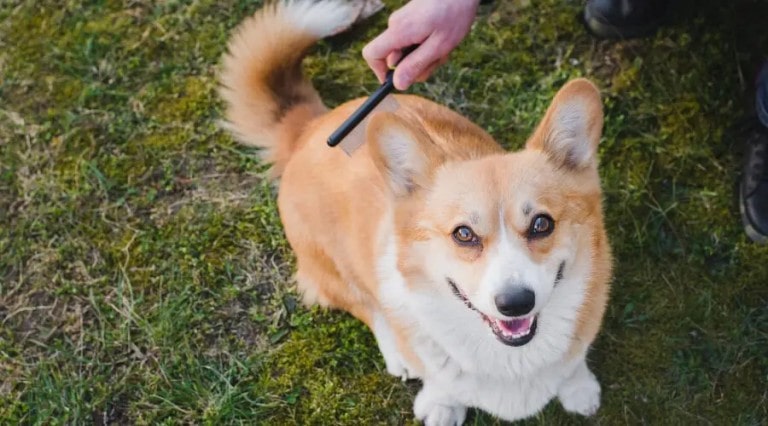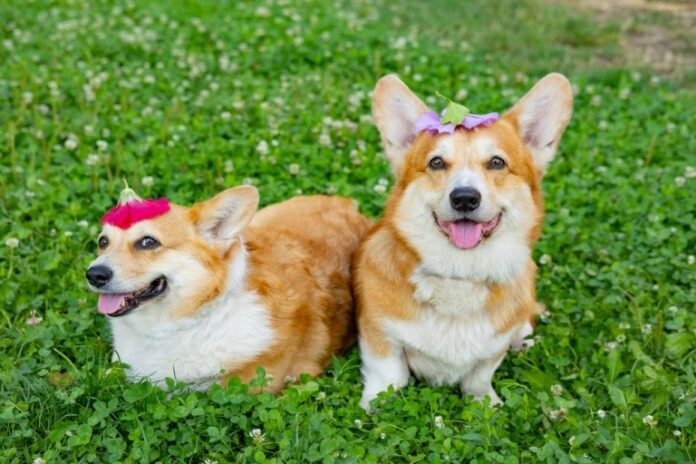So, you’re thinking of obtaining a Corgi, huh? Excellent choice!
They’re smart, flexible creatures. You don’t have to worry about keeping them in a small apartment, and you won’t have a hard time training them.
However, you need to keep in mind there are cons to raising a Corgi, chief among which is their shedding problem.
Do Corgis shed a lot? They do. If you can’t stay on top of your cleaning game, Corgis may not be the best option for you.
So, how often do they shed? What can you do about it?
Well, in this article, we’ll answer all your questions, and you’ll become an expert in Corgi shedding.
Are Corgis Heavy Shedders?
Yes, Corgis are heavy shedders.
Expect to see a good amount of fur on everything your Corgi touches, whether it’s your floor, clothes, or furniture.
You see, to withstand seasonal changes and extreme weather, Corgis have two layers of hair. They’re called a double coat.
The bottom, soft layer keeps Corgis warm in the winter and cool in the summer. The top layer protects their skin and provides room for air after shedding.
Naturally, more fur means more shedding.
While Corgis shed daily, they blow their coat during spring and fall.
Blowing their coat refers to shedding more hair than any other time of the year to adjust to weather changes.
So, in fall, Corgis start shedding as they produce thick layers of fur to keep them warm during winter. In spring, they lose a lot of that hair to prepare for the heat of the summer.
Corgis blow their coat over 2-4 weeks. So, you’ll have to be patient with your dog.
Can Corgis Shed Too Much?
 Image source: Google
Image source: Google
We’ve established that Corgis are heavy shedders. However, that doesn’t mean you should overlook their excessive shedding.
There are cases where it could be a bad sign. So, let’s see some examples.
Malnutrition
If we don’t follow a healthy, balanced diet, it shows on our faces. Our skin gets saggy, we start losing our hair, etc.
Guess what? Dogs are the same.
Omega-3 fatty acids are essential for keeping your dog’s skin and hair follicles healthy.
If your dog isn’t getting all the necessary nutritional elements they need, their fur starts to dry, maybe even thin out a little bit. Eventually, they start losing hair altogether.
Allergies
Corgis can be allergic to all sorts of things: dust, pollen, certain food ingredients, etc.
Most of these allergies can make your dog itchy.
So, you can tell your Corgi is having an allergic reaction when they start scratching, biting, or licking the itchy spots excessively. You can also look for red skin, bald spots, and eye irritation.
Naturally, scratching and licking result in excessive hair loss, even more so than usual.
If you suspect your dog is shedding because of an allergic reaction, check with your vet to see how you can manage that allergy.
Stress
Yes, animals can experience stress as well.
Dogs are creatures of routine. So, when that routine is broken, their anxiety goes into overdrive.
If you’ve moved to a new house, the sudden change in environment can be overwhelming.
Maybe you decided to walk them on a different street, and the new faces or car noises are stressing them out.
Even a trip to the vet is enough for them to start releasing epinephrine, one of the main stress hormones in dogs.
This, in turn, leads to excessively shedding hair.
If your dog only exhibits symptoms of anxiety when they’re with your friends, you might be looking at a case of separation anxiety.
Interacting with strangers for the first time can be an overwhelming experience for dogs.
They may need some time to get used to new people.
If you leave them with a friend or a relative they’re not familiar with, they’re bound to feel stressed out.
So, your dog will shed excessively, and you’ll have a hard time pinpointing the reason.
Hormonal Issues
Sometimes, your dog can experience a hormonal imbalance; that’s overproducing or underproducing certain hormones.
This imbalance makes them susceptible to endocrine diseases. Each disease comes because of the lack or abundance of certain hormones.
For example, if your dog doesn’t produce enough thyroid hormone, it can get hypothyroidism. Hypothyroidism can cause your dog’s hair to gradually thin out and fall altogether.
The adrenal glands of your Corgi might be producing too much cortisol, in which case they’re bound to have Cushing’s disease.
While thinning hair and alopecia are common symptoms of Cushing’s disease, you can identify it if your dog starts drinking too much water and urinating too often.
Pregnancy
Think of it like this: if your Corgi is a lawn, pregnancy is a lawn mower.
Not only does the hormonal imbalance associated with pregnancy cause your dog’s hair to fall, but the nourishing phase also absorbs many of the substances needed to grow a healthy coat.
You see, Corgis need a lot of minerals, vitamins, and fatty acids to develop healthy fur.
While the mother nurses her pups, these nutritional elements are directed toward the little ones.
Since she lacks the necessary minerals, the mother starts shedding excessively.
Don’t worry, though. It’s not permanent. She’ll start growing hair again, eventually.
Parasites
At first glance, it might seem weird that parasites can cause hair loss.
After all, fleas and mites just cause skin irritation and itching, right? But that’s the point!
Excessive scratching can cause hair loss in itchy areas.
 Image source: Google
Image source: Google
How to Deal With Hair Shedding?
While you can’t stop your Corgi’s shedding, you can manage it so it doesn’t get out of hand.
1. Following a Balanced Diet
Your dog needs a sufficient supply of nutrition to develop healthy layers of fur. The easiest option you can go with here is dry kibbles.
However, make sure they’re rich in Omega fatty acids. They’ll give your dog a smooth layer of fur, and you’ll have less hair on your hand the next time you pet them.
2. Regular Bathing
Taking regular baths is an effective method to get rid of dead fur and excess hair. However, there’s such a thing as over-bathing, and it can be counterproductive.
If you bathe your dog too often, you get rid of the natural oils inside its skin, resulting in dry fur waiting to fall on your floor.
You should bathe your dog 2-4 times a month. Any more than that, and they might get skin irritation, which will lead to more shedding.
If your dog is blowing their coat, you can bathe them more frequently.
3. Choosing the Right Kind of Shampoo
Yes, even your shampoo can make a difference. If you use human shampoo on your dog, now is a good time to stop.
It’s easy to overlook this step but keep in mind humans have a different skin structure than dogs.
Shampoos are made with that difference in mind. While human shampoos won’t necessarily hurt your dog right away, they can cause hair loss in the long run.
If your dog is shedding excessively, you can use specific shampoos that are made to reduce that.
4. Regular Brushing
This is probably the most efficient step on the list to manage your Corgi’s shedding.
When you brush your dog, not only do you get rid of excess hair, but you also stimulate the flow of natural oils on the coat.
This, in turn, improves their skin and fur health, as these oils keep their hair smooth and protect their skin.
You should brush your dog at least three times a week. If your dog is blowing their coat, daily brushing would be advisable.
Use proper tools, and don’t be too harsh. We don’t want to hurt our furry friend.
A regular pin brush will do the trick, but you can use an undercoat rake if you want.
Wrapping Up
So, do Corgis shed? Yes, excessively so.
Corgis have two layers of hair to adapt to seasonal changes. Naturally, that means they shed more hair than the average dog.
However, sometimes that can be a sign of a problem. So, don’t overlook it.
Excessive shedding is manageable, though. There are several actions you can take to reduce it, whether it’s regular brushing or following a healthy diet.



